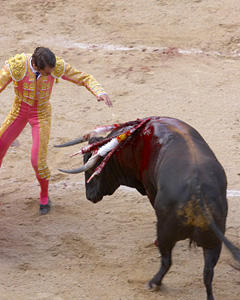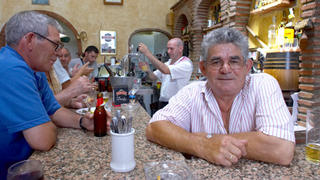
Luckily for me my companion was knowledgable on the subject and a good teacher. Until that night the notion of the matador and bull fighting was a mystery more than anything, the reality of the bull's fate merely a conceptual consequence. Now it seems real and I dont know whether I am more amazed by the brave foolishness of the men who fight the bulls, or by the bloody and inevitable demise of the 'Toro'. I did walk away with a deep appreciation for some of bull fighting's nuances, and true respect for a little man named Sanchez Vara.
Our programme guide featured a photo of the three matadors who performed. Diego and Fernandez are pictured in elegant poses suggestive of worldy men who could make women swoon with the tip of a hat. Sanchez however is shown expressing a goonish howl, further accentuated by his flappy ears which stick out like little prince charlies. First glance and we dubbed him 'Monkey man', and sat back to experience the performance.
Two things are essential to make sense of bull fighting. Firstly there are three matadors and six bulls featured on any given night. Second is that the bull is not given a fair chance. The process of weakening the bull echoes of tradition and takes place in various stages. When he first enters the stage the bull is confused and most likely has no idea of what will follow. This makes the following events all the more tragic for the bull. It is his fiest and ferocity that people come to see, yet the matador is armed with knowledge and a team of men to draw the poor animal to his doom.
The bull enters the ring and sees four men waiving capes. He is angry and reacts to the taunts quickly enough. These men are not matadors themselves but are part of the matador's team - collectively they are known as the torero. The matador shows up now and sends the other men to hide behind wooden hoardings. There is a little bit of show here as the bull is revealed to be quick with temper. The brass section of the band burst out a few notes and the picadores are brought onto the ring. Stage one of the weakening. Picadores are men on horses who will drive daggers into the bull and begin the blood letting. The horses are blind folded and armoured with a skirt of metal. When first I saw a bull attack the horse I was stunned. I didnt realise it was part of the pan and thought the rider to be in mortal danger and horse to be in need of a bullet. But what really happens is the bull is tricked into attacking the picadore and receives a savage couple of stabs for his trouble. The picador must be careful not the over play his task else the matador will be denied a suitable opponent.
With blood literally streaming out of the bulls wounds the next stage begins. The matador or his banderilleros are handed banderillas, colourfully presented sticks with barbed arrow heads on them. The banderillas will be thrust into the bull's wounded back when the bull attempts to charge. There are no capes to distract the bull at this stage, so the skill of the man involved is all that protects him. The charging bull is a target now, the banderillo must be close enough to thrust into the bull but far enough to avoid being gored.
Stage three. The bull is now in a very weakend state. Not only has blood been gushing out of several wounds for over 10 minutes but all the while the bull has been in a hightened state of aggression. He is breathing with all his strength. The matador now leads the bull through a few more paces and draws the crowd deeply into the moment with his balletical performance. To my eye it appears to be a process of conditioning the bull's mind. The maneouvres are smaller, tigher and draw the bull into an intense focus on the red cape. Soon the bull is ready for the final blow, refered to as the moment of truth. The matador will strike a sword directly between the bulls shoulder blades and severe the arteries leading to the heart. If done right the bull's heart will cease and death is quick. Very little margin for error is allowed - if the preparation of the bull has been insufficient and he is not properly weakened then the matador is at great risk.
Our good man, Sanchez Vara, demonstrated the seriousness of the undertaking in the most spectacular fashion. While working towards the moment of truth Sanchez allowed himself to focus too heavily on the drama itself and lost concentration for a split second. The bull managed to flip him over the top. The moment was powerful. Everyone watched in stunned surprise, waiting to see what would happen. The immediate danger is trampling from the bull, or a second charge to gore and crush his bones. Barely a few seconds passed but it seemed like an hour. We were amazed when Sanchez got to his feet, the relief swept around the stadium, and then in awe as he grabbed his cape and sword and angrily shouted to the toreros that he needed no assistance with the bull. A few seconds later Sanchez was alone with the bull and back in charge. The crows went wild, women standing on their seats waving white hankerchiefs. He had won their admiration and hearts.
"A bullfight is not a sport. It is a liturgy, a drama, a performing art graced with esthetic refinement, exceptional bravery and religious symbolism," - James F. O’Dwyer(The Art of the Matador)
